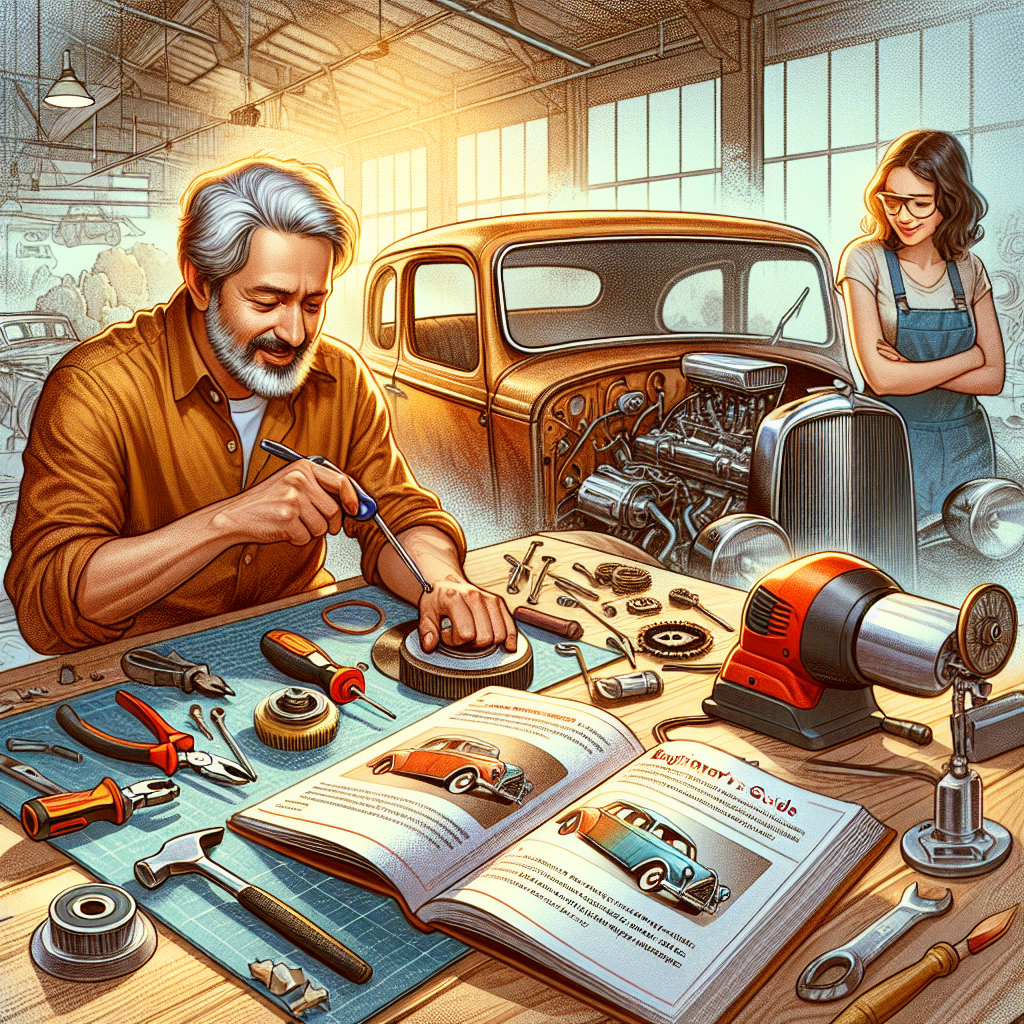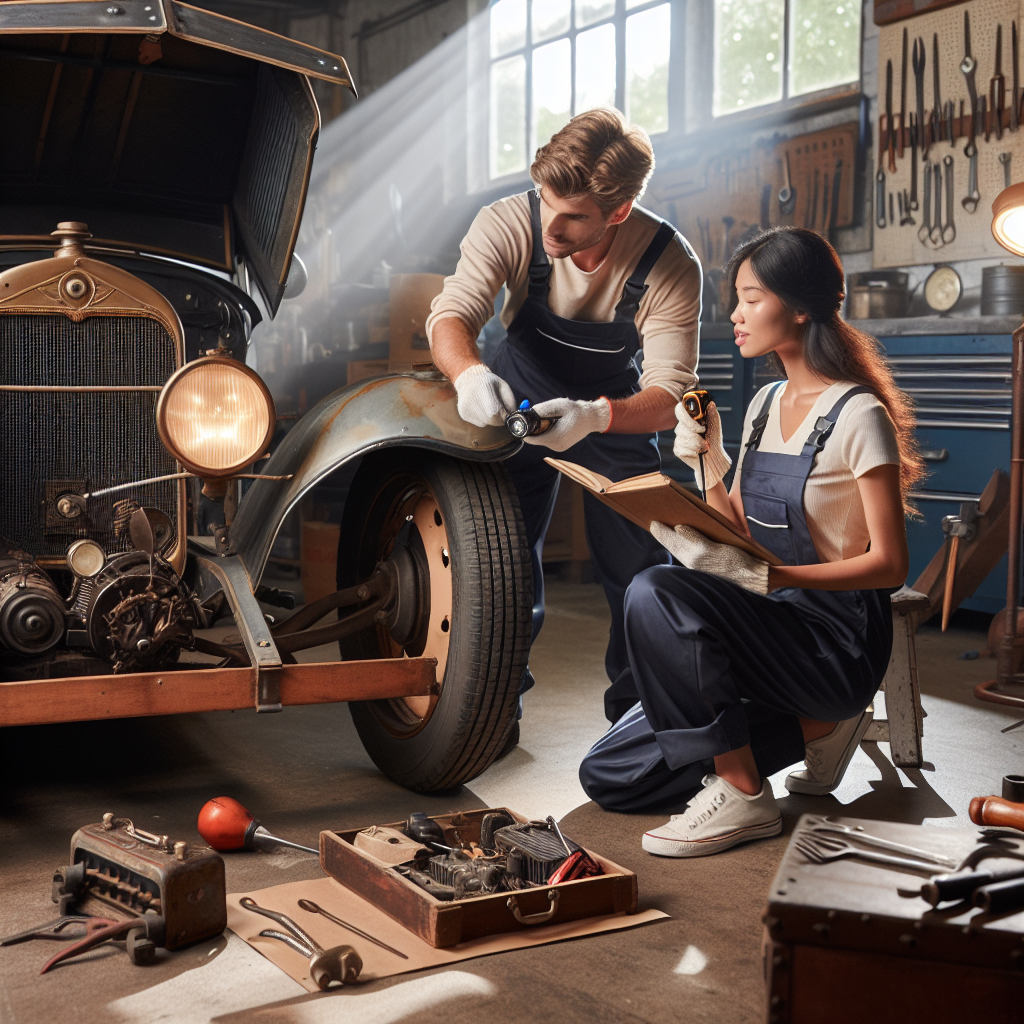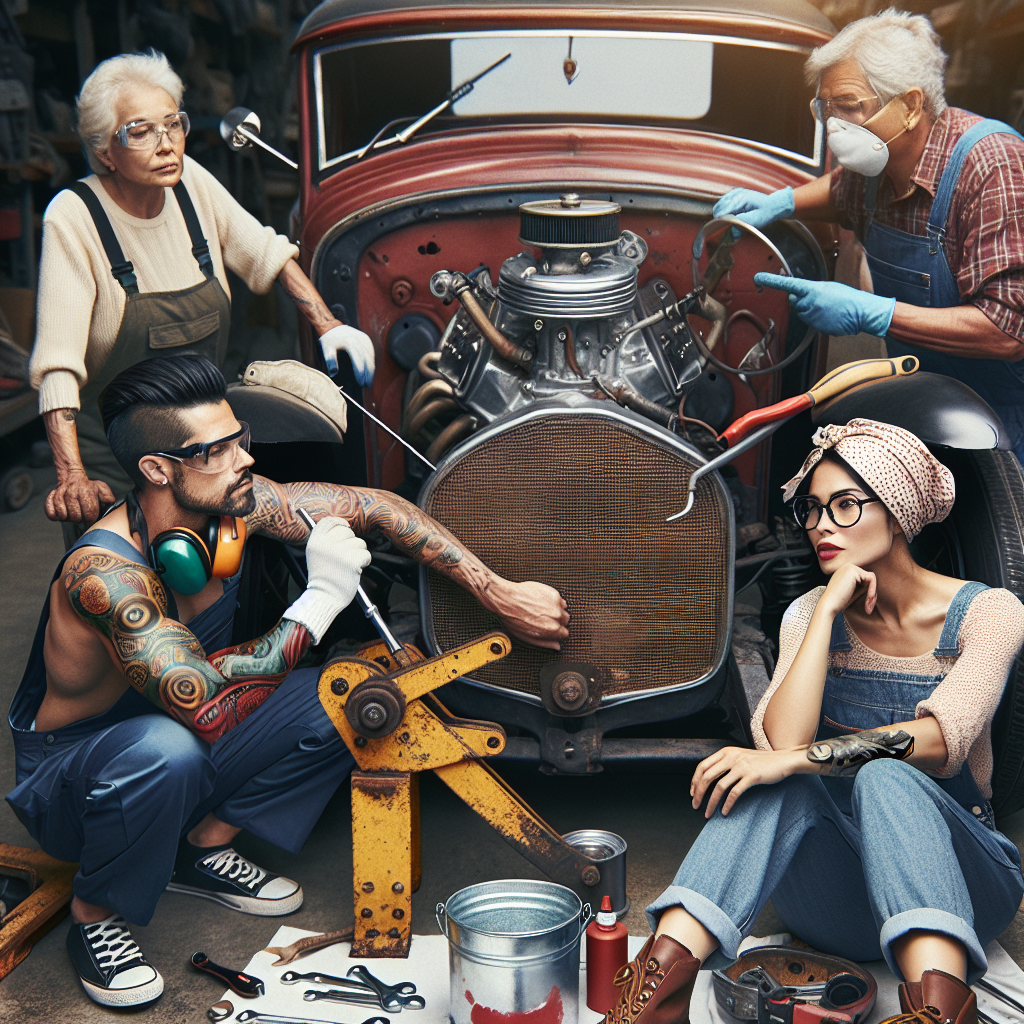Embarking on the exciting journey of car restoration as a beginner can be both challenging and rewarding. From rusty old classics to forgotten gems, breathing new life into these automotive treasures requires patience, dedication, and a passion for reviving the past. In this Beginner’s Guide to Car Restoration, we will delve into the world of car restoration, offering essential tips, tricks, and techniques to help you bring your dream car back to its former glory. Whether you’re stripping down an engine or polishing chrome, get ready to roll up your sleeves and unleash your inner car enthusiast as we take you through the ins and outs of restoring vintage vehicles.
Understanding the Basics of Car Restoration
Car restoration is a meticulous process that requires a keen understanding of the fundamentals to ensure a successful project. Here are key aspects to consider when delving into the world of car restoration:
- Importance of Researching and Planning
Researching and planning are crucial steps in the car restoration process. Before embarking on a restoration project, it is essential to gather information about the specific make and model of the car you intend to restore. This includes understanding the original specifications, available parts, and common issues associated with the vehicle. Thorough research will help you make informed decisions and avoid costly mistakes throughout the restoration process.
- Setting Realistic Goals and Budget
Setting realistic goals and a budget is vital for a successful car restoration project. Determine the extent of restoration you aim to achieve, whether it is a full restoration to original condition or a partial restoration focusing on specific aspects of the car. Establishing a clear vision of your goals will guide your restoration efforts and help you stay on track. Additionally, setting a budget early on will prevent overspending and ensure that you allocate resources efficiently throughout the restoration process.
- Choosing the Right Car for Restoration
Selecting the right car for restoration is a critical decision that can significantly impact the success of your project. Consider factors such as the availability of parts, the overall condition of the vehicle, and your level of expertise when choosing a car to restore. It is advisable to start with a relatively straightforward restoration project that matches your skill level to build confidence and experience before tackling more complex restorations. By choosing the right car for restoration, you set yourself up for a rewarding and fulfilling experience in bringing a classic vehicle back to its former glory.
Essential Tools and Equipment for Car Restoration

Car restoration requires a variety of tools and equipment to successfully bring a vehicle back to its former glory. Whether working on the mechanical components or the bodywork of the car, having the right tools is essential for a smooth restoration process. Below are the key categories of tools and equipment needed for car restoration:
Mechanical Tools
- Socket Set: A comprehensive socket set with various sizes is essential for working on different parts of the car, including the engine and suspension components.
- Wrenches: Both standard and metric wrench sets are necessary for loosening and tightening nuts and bolts throughout the vehicle.
- Screwdrivers: A set of screwdrivers, including flathead and Phillips head, is crucial for removing panels and other components.
- Pliers: Different types of pliers, such as needle-nose and locking pliers, are handy for gripping and bending various parts during the restoration process.
Bodywork Tools
- Sanding Tools: Sanding blocks, sandpaper in various grits, and a dual-action sander are needed for smoothing out imperfections in the car’s body.
- Body Filler: Bondo or body filler is essential for repairing dents and dings before priming and painting the car.
- Paint Sprayer: A quality paint sprayer is necessary for achieving a professional finish when painting the restored car.
Safety Equipment
- Safety Glasses: Protecting your eyes from debris and fumes is crucial, making safety glasses a must-have item in your restoration toolkit.
- Gloves: Work gloves help protect your hands from cuts, scrapes, and chemicals while working on the car.
- Respirator Mask: When working with paints, primers, or other chemicals, a respirator mask is essential for safeguarding your respiratory health.

Disassembling the Car
Disassembling a car is a crucial step in the restoration process as it allows you to assess the condition of each component and plan for necessary repairs or replacements. Here are some key points to consider when disassembling your car:
- Documenting the Process
Before you start disassembling the car, it is essential to document the process thoroughly. Take photographs from various angles, make notes of where each part is located, and consider creating a checklist to ensure nothing is overlooked during reassembly.
- Organizing and Labeling Parts
As you remove parts from the car, it is important to organize and label them systematically. Use plastic bags or containers to store smaller components and label them clearly with the part name and where they belong in the vehicle. This will save you time and confusion when putting the car back together.
- Dealing with Rust and Corrosion
While disassembling the car, you may encounter rust and corrosion on certain parts. It is crucial to address these issues promptly to prevent further damage. Consider using rust removal solutions, sandblasting, or replacing severely affected components to ensure the structural integrity of the vehicle.
Evaluating and Repairing the Engine
When embarking on a car restoration project, evaluating and repairing the engine is a critical step that requires attention to detail and precision. The engine serves as the heart of the vehicle, providing the power necessary to make it run smoothly. Here are some essential aspects to consider when assessing and restoring the engine:
- Inspecting for Damage:
- Begin by conducting a thorough visual inspection of the engine components to identify any signs of wear, corrosion, or damage. Look for leaks, cracks, or unusual noises that may indicate underlying issues. Pay close attention to the cylinders, pistons, and valves for any noticeable wear and tear.
- Utilize diagnostic tools such as a compression tester or leak-down tester to assess the engine’s overall health and performance. These tools can help pinpoint specific areas that may require repair or replacement.
- Rebuilding and Replacing Parts:
- If significant damage or wear is detected during the inspection, consider rebuilding or replacing certain engine parts to ensure optimal functionality. This may involve overhauling the cylinder head, replacing gaskets, or refurbishing the crankshaft.
- Consult the vehicle’s service manual or seek guidance from experienced mechanics to determine the best course of action for rebuilding or replacing engine components. Pay attention to torque specifications and assembly procedures to prevent any potential issues during reinstallation.
- Upgrading for Performance:
- For enthusiasts looking to enhance their car’s performance, consider upgrading the engine with aftermarket parts or performance modifications. This could include installing a high-performance camshaft, upgrading the fuel system, or adding a turbocharger for increased power output.
- Before making any upgrades, research compatibility with the existing engine components and ensure that the modifications align with your restoration goals. It’s essential to strike a balance between performance enhancements and maintaining the engine’s reliability and longevity.
By carefully evaluating and repairing the engine during the car restoration process, enthusiasts can ensure that their vehicle not only looks great but also performs optimally on the road.
Restoring the Body and Paintwork
When embarking on a car restoration project, one of the key aspects to focus on is restoring the body and paintwork. This process involves repairing any dents and dings, prepping the surface for paint, and selecting the appropriate paint and finish to achieve a professional-looking result.
Repairing Dents and Dings
Identifying Damage:
Before beginning any repairs, carefully inspect the body of the car to identify areas with dents and dings. These imperfections can often be caused by accidents, hail damage, or general wear and tear.
Tools and Techniques:
To repair dents and dings, various tools and techniques can be used, such as paintless dent repair kits, body filler, and sanding tools. For smaller dents, paintless dent repair is a popular method that involves massaging the dent out from the inside of the panel.
Professional Assistance:
In cases where the damage is extensive or requires specialized skills, seeking the help of a professional body shop or auto body technician may be necessary to ensure the repairs are done correctly.
Prepping for Paint
Surface Preparation:
Achieving a flawless paint finish starts with proper surface preparation. This involves sanding down the existing paint, removing rust spots, and ensuring the surface is clean and smooth before applying new paint.
Priming the Surface:
After prepping the surface, applying a coat of primer is essential to create a smooth and uniform base for the paint to adhere to. Primer also helps to prevent corrosion and improves paint adhesion.
Masking and Taping:
Before painting, it is crucial to mask off areas that should not be painted, such as windows, trim, and rubber seals. Using high-quality masking tape and paper ensures clean paint lines and protects surrounding areas from overspray.
Choosing the Right Paint and Finish
Types of Paint:
When selecting paint for your car restoration project, consider factors such as durability, color match, and ease of application. Acrylic enamel, acrylic lacquer, and urethane are common types of automotive paint that offer different levels of durability and finish.
Finish Options:
The finish of the paint can range from matte to high gloss, depending on personal preference and the desired look for the vehicle. Clear coats can also be applied to enhance the shine and protect the paint from UV damage and environmental elements.
Professional Advice:

If unsure about the best paint and finish options for your car restoration project, consulting with automotive paint specialists or experienced car enthusiasts can provide valuable insights and recommendations based on your specific needs and budget.
Reassembling and Fine-Tuning the Car
After successfully disassembling and restoring various components of the car, it is crucial to now focus on the reassembly process. This stage requires meticulous attention to detail to ensure that all parts are correctly put back together for the car to function optimally.
Following the Documentation
Refer back to any documentation, manuals, or guides that were used during the disassembly phase. These resources will provide valuable insights into the proper sequence of reassembly and the specific torque specifications for various components. Following the documentation diligently will help prevent errors and ensure that the car is put back together accurately.
Testing the Systems
Once the car has been reassembled, it is essential to conduct thorough testing of all systems. This includes checking the electrical components, engine performance, brakes, steering, and any other systems that were worked on during the restoration process. Testing the systems will help identify any issues or malfunctions that may have arisen during reassembly.
Fine-Tuning for Optimal Performance
After testing the systems, fine-tuning is necessary to achieve optimal performance. This may involve adjusting settings, calibrating components, or making minor tweaks to enhance the overall functionality of the car. Fine-tuning is a critical step that can significantly impact the performance and longevity of the restored vehicle.
FAQs: Beginner’s Guide to Car Restoration
What is car restoration?
Car restoration is the process of repairing, refurbishing, or rebuilding a classic or vintage car to its original condition. This typically involves taking apart the car, fixing any mechanical or cosmetic issues, and then putting it back together.
What tools do I need for car restoration?
Some essential tools for car restoration include wrenches, screwdrivers, socket sets, pliers, hammers, and sandpaper. You may also need specialty tools like a car lift, paint spray gun, or engine hoist depending on the extent of the restoration project.
How much does car restoration cost?
The cost of car restoration can vary widely depending on the condition of the car, the extent of the work needed, and the quality of the parts and materials used. It’s important to establish a budget before starting a restoration project and to prioritize which areas of the car need the most attention.
How long does car restoration take?
The time it takes to complete a car restoration project can vary depending on the condition of the car and the scope of the work involved. Some projects can be completed in a few months, while others may take several years to finish. Patience and dedication are key when embarking on a car restoration journey.
Do I need special skills to restore a car?
While having mechanical knowledge and experience can be helpful when restoring a car, it is not necessarily required. There are plenty of resources available, such as instructional videos, books, and online forums, that can help beginners learn the necessary skills. Starting with a simpler restoration project and working your way up can also be a good way to gain experience.
